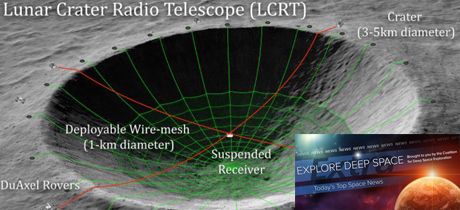In Today’s Deep Space Extra… Three U.S. and Russian astronauts and cosmonauts launched early Thursday to the International Space Station (ISS) for a six month mission aboard a Russian Soyuz rocket. The joint European/Japanese Mercury bound Bepi Columbo spacecraft flies by Earth on Friday.
Human Space Exploration
Upgraded Soyuz rocket with crew of three launched to Space Station
Coalition Member in the News – Boeing
CBS News (4/9): NASA astronaut Chris Cassidy and Russian cosmonauts Anatoli Ivanishin and Ivan Vagner launched to the International Space Station (ISS) Thursday at 4:05 a.m., EDT, They are scheduled to dock at the Station’s Russian segment at 10:15 a.m., to begin a six month mission that is planned to include the arrival of Boeing and SpaceX commercial crew test flights. Streaming of the docking is available at www.nasa.gov/nasalive.
Space Science
NASA funds giant radio telescope concept on far side of Moon
Futurism (4/7): As part of the NASA Innovative Advanced Concepts initiative, the agency is exploring a concept for a radio observatory on the Moon’s far side, the Lunar Crater Radio Telescope. Deployed robotically, the observatory could seek evidence for extraterrestrial intelligence without interference from other broadcast sources.
WFIRST will use relativity to find more exoplanets!
Universetoday.com (4/7): As designed, the Wide Field Infrared Space Telescope (WFIRST) under development by NASA would look out to deep space with a field of view 100 times that of the Hubble Space Telescope. It could also employ gravitational lensing to sharpen the search for extra solar planets. The approach relies on an alignment among stars and their gravitational forces to magnify light from distant sources reaching the observatory.
Masten wins NASA lunar lander award
SpaceNews.com (4/8): NASA on Wednesday contracted with Masten Space Systems to launch nine science and technology payloads to the surface of the Moon at the south pole in late 2022. Each will help to characterize the lunar soil and environment in the region ahead of plans by NASA to make an accelerated return to the lunar surface with human explorers in 2024.
Bepi before space
European Space Agency (4/8): The joint European and Japanese space agency Bepi Columbo spacecraft will pass close to the Earth on Friday to alter its trajectory toward Mercury. The spacecraft should be visible to observers in the southern hemisphere and southern parts of the northern hemisphere. Launched in 2018, the mission’s three modules are to reach Mercury in December 2025, after two flybys of Venus and six of Mercury.
How astronomy’s largest telescopic Array is revolutionizing planetary science
Forbes (4/8): The decade old Atacama Large Millimeter/submillimeter Array radio telescope in Chile is proving its value to astronomy. Among its discoveries: the presence of ionized oxygen at a distance of 13.28 billion light years, a mere half billion years after the big bang.
Could Mars samples brought to Earth pose a threat to our planet? What the coronavirus (and ‘Andromeda Strain’) can teach us
Space.com (4/8): Planetary protection is no small matter. In July, NASA’s Perseverance 2020 Mars rover is to launch for Mars, where it will gather and cache samples of soil and rock for return to Earth in the 2030’s. Experts are carefully assessing how to protect the Earth from possible Mars contamination and Mars from Earthly microbes.
Other News
HASC Chairman: Space Force launch contracts should stay on schedule to help industrial base
Coalition Members in the News – Northrop Grumman, United Launch Alliance
SpaceNews.com (4/7): U.S. Rep. Adam Smith, chair of the House Armed Services Committee, on Tuesday said the U.S. Space Force should not delay plans to select two launch service providers in mid-2020 under five year agreements for national security missions. United Launch Alliance (ULA), Northrop Grumman, Blue Origin and SpaceX are among the contenders.
Raymond: Space Force acquisition proposals are about ‘going fast’
SpaceNews.com (4/7): Recommendations on their way to Congress on how military space systems are funded and acquired promise to accelerate how the new U.S. Space Force is set up to deal with growing national security threats posed by Russia and China, according to Chief of Space Operations General John Raymond on April 7.

